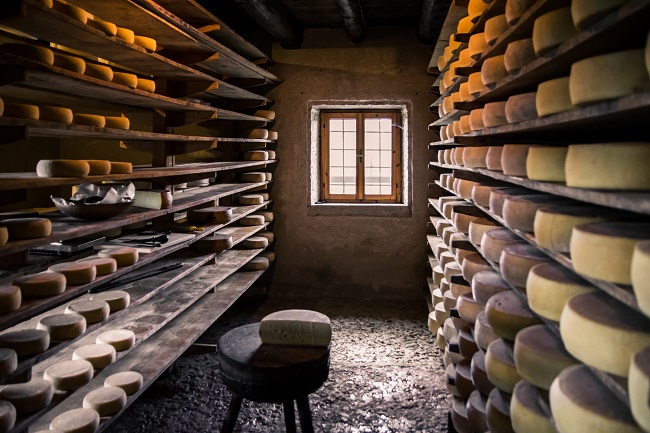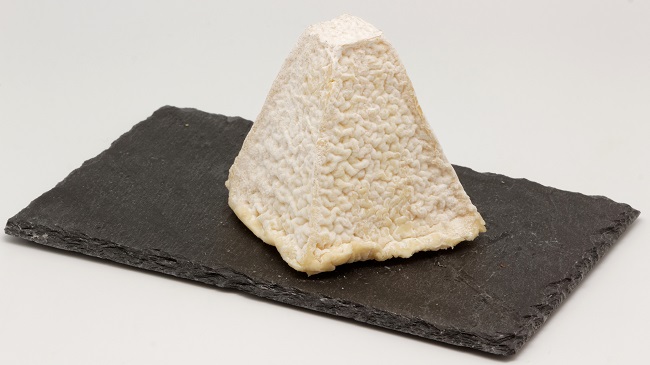Meet Thierry Cartereau, French Cheese Ager

There’s more to cheese than curdling milk. Aging the cheese is an art in itself, and we met with one of its finest craftsmen in France
Cheese-loving visitors to the Loire Valley city of Tours are certain to cross paths, even tangentially, with Thierry Cartereau. The reedy cheesemonger holds court most often at his fromagerie in the central covered market, but the reality is that Cartereau’s influence permeates the entirety of the local cheesescape.
For over 20 years, Cartereau has exercised his craft as a fromager-affineur, a double-barreled career that encompasses not just the sale but also the aging – affinage – of cheese. Indeed, for France’s over 1,200 cheeses, curdling milk is just the beginning: distinct aging processes are what will lend the umami-rich notes to stinky washed-rind Langres or the buttery caramel essence to a pressed Beaufort. And while some cheesemakers age on-site, others entrust agers like Cartereau to finish the task.
But while many cheesemongers purport, as he does, to take part in this essential element of cheesemaking, those who truly exercise this craft are few and far between, at least according to Cartereau.
“Only 20 percent of cheesemongers age,” he says, noting that the space required – not to mention the time it takes to do the job properly, waiting until cheeses are perfectly ripe – has deterred many in his industry from aging more than a handful of small-format cheeses on-site. But Cartereau is determined to help cheeses reach their full potential before they land in the hands of consumers. “By working directly with producers,” he says, “you can help your products reach a certain stage, and then I add my own personal touch after.”

Aging cheese is not for everyone: you need the space and the patience for it © shutterstock
Teaching a younger generation of cheese agers
But Cartereau isn’t just a firm defender of the affineur part of his role. His connections to producers begin long before the cheeses arrive at the Halles; indeed, over the course of his long career, he has become even more hands-on than the most devoted of his colleagues. “I started out selling,” he says, “and while looking for raw milk producers, I encountered young people and started helping them.”
To hear Cartereau tell it, it was a producer of Pouligny-Saint-Pierre – one of five AOP-protected goat cheeses produced in the region – who inspired him to start developing the cheeses he would sell before they even left the farm. After helping this young farmer get their business off the ground, he found himself drawn to help others making local specialties ranging from Sainte-Maure de Touraine to Selles-sur-Cher, a task that has become even more essential with the upswing in young people gravitating towards these long-maligned career options thanks to a changing perception of métiers de la bouche.
“There may have been a time eight or so years ago when media reports seemed to indicate weak interest among younger generations to carry on the tradition,” muses Lindsey Tramuta, Paris-based journalist and author of The New Paris and The New Parisienne, “but the ongoing search for meaning in professional ventures, a phenomenon I documented in The New Paris, continues to benefit the industry.”
Young people, then, are putting down roots in cheesemaking – and Cartereau is there to help. “It’s human!” he says. “I’m really grateful to these young people, because many don’t quite realize what goes into making a cheese.”
These days, Cartereau has become a bit of a cheesemaker hotline incarnate: friends and colleagues often send newcomers his way when they need help or guidance. He takes the time to go on-site, visiting with the producer, tasting their product, and offering advice for ways to improve: anything from changes in diet to care of the animals to technical tips for the production and early aging of the cheese. “When you’re aging, you can age at a normal temperature, or you can make it ferment again with another temperature… there are so many criteria that come into play,” he says.
He’s recently become interested in a burgeoning producer of a local raw goat’s milk camembert. “There’s work to be done, to elaborate, to finesse, so that it becomes something really awesome,” he says. “And if that works out, a raw, goat’s milk camembert… well, that really doesn’t exist anymore, so that will be a great opportunity.”

Pouligny-Saint-Pierre, one of the five AOP cheeses of Indre © Coyau / Wikimedia Commons / CC BY-SA 3.0
A passion for raw milk cheese
Lucie Oger is one cheesemaker who has enjoyed Cartereau’s help, advice, and support for “a good year now.” The 28-year-old recounts that he reached out to her two years after she returned home to Indre-et-Loire following studies in cheesemaking in Haute-Savoie. Her parents had long raised dairy cows, but rich in her new experience, Oger was intent on transforming at least some of that milk on-site.
“What I really liked was that he was the one who reached out to me,” she says of Cartereau. “He came all the way out here, to the farm, and he was really intent on visiting my cellars, seeing what I do, talking on the farm, really having a conversation on how we make cheese.”
And since both Oger and Cartereau are passionate about raw milk, it truly was a match made in heaven. “It’s really nice that he defends those same values,” she says.
These days, Oger transforms about 15 percent of the family production on-site into offerings that include rarities for the region: pressed cow’s milk cheeses, Savoie-style raclette. But one of Thierry’s coups de coeur was her Cœur de Démée, an Abondance-adjacent pressed cheese with a nutty, buttery flavour and a slight funk. “Thierry sells a lot of it at his shop,” she says. “It’s the kind of cheese people don’t really make here.”
Oger ages hers on-site in natural cellars with custom-built shelves; Cartereau came by, she says, and gave her advice on the best volumes to stock at any given time for optimal aging. “There are loads of little, kind of technical things,” she says. “I’d been doing it for two years by then, so he gave me two or three little tips.”

Lucie Oger, a young cheese ager in Indre-et-Loire
Crackers about selling cheese
Cartereau obviously has the know-how to make his own cheese, but when asked if he’s ever considered devoting himself to it full-time, he scoffs. “I’d need to close the shop!” he says. “I can’t be everywhere at once.”
And selling cheese is indeed the thing he seems most passionate about; his meanders through the world of cheesemaking are linked more to ensuring he can stock his shelves with top-quality products than an innate love of the transformation of milk. “I like the shop,” he says, not only as a place for encountering people, but as a place for declaiming his passion for raw milk cheese.
And continuing to occupy his Halles stall means that he can do more to help those cheeses get to more people: not just individuals, but top restaurateurs. Indeed, Cartereau works closely, notably, with two-Michelin-starred Christophe Hay of La Maison d’à Côté. The pair met at the CFA (centre de formation d’apprentis) de Tours, recounts Hay, and they immediately hit it off. “Thierry introduced me to Gouda de Touraine,” he recalls. “And we dug together to find the Kuipers family… a really lovely discovery for me, thanks to Thierry.”
And while Hay doesn’t usually work with mongers, preferring to cooperate directly with producers, Cartereau is a bit of an exception. “Thierry is a sourcer,” says Hay. “The idea of a cheesemonger is also sourcing cheeses a bit all over France, because a cheesemonger is kind of a cheese wholesaler.”
Since Hay’s values lead him to focus on hyper-local cheeses, Cartereau is less of his provider and more of his guide. “He has led me to regional producers,” he says, “and I don’t work with any other cheesemongers, as it were.”
He applauds Cartereau’s exploration of younger cheesemakers. “The idea is above all to valorise the terroir, to valorise the human side,” he says, “and to, of course, shine a light on producers who today do amazing work but are not always valued.”
Whenever a cheesemaking light shines under a basket, Cartereau is there to unveil it, as he did with Oger’s Coeur de Démée: This pressed cheese now appears, thanks to Cartereau, atop a burger at Tatoué Toqué, the restaurant helmed by Benoit Sanchez, 2022 World Food Championships silver medallist in the burger category. “Thierry got cheese from me to supply him,” she says. “And it was so amazing when Thierry told me he was going to put the Coeur de Démée on his menu.”
Working with Thierry, she says, is a boon for young people in the industry. “He seems to be pretty well-known in the world of cheese,” she says. “And he has a great network too.”
She mentions notably Hay, who, it seems, may begin to feature her local cheese at his restaurant soon. “I just sort of tell myself that… if he’s suggesting my stuff to chefs like that, if he has confidence in my products… I must be doing something right.”
Lead photo credit : Thierry Cartereau in his beloved cheese shop in Tours © Emily Monaco
Share to: Facebook Twitter LinkedIn Email
More in cheese, cheesemonger, French cheese
By Emily Monaco
Leave a reply
Your email address will not be published. Required fields are marked *




REPLY
REPLY